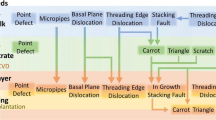Abstract
Thin separation by implanted oxygen substrates are attractive candidates for low-power, low-voltage electronic devices and can be obtained by low-dose, low-energy oxygen–ion implantation. We report in this study a variation of the process parameters that have never been investigated before, particularly for implantation with a high current density implanter. Characterization of the sample sets by transmission electron microscopy, secondary ion mass spectroscopy (SIMS), and Rutherford backscattering spectrometry (RBS) shows an optimum dose of 3.0 to 3.5 × 1017 O+/cm2 at 100 keV for forming a continuous buried oxide (BOX) layer compared to 2.5 × 1017 O+/cm2 at 65 keV. At this optimum condition for 100 keV, the thickness of Si top layers and BOX layers is in the range of 175–185 nm and 70–80 nm, respectively. Analysis of the breakdown voltage of small area capacitors shows a breakdown field in the range of 6.0–7.0 MV/cm, which is adequate for low-power, low-voltage devices. SIMS analysis shows that the maximum oxygen concentration of as-implanted samples is located at depths of 160 and 240 nm for the implantation energy of 65 and 100 keV, respectively. A significant redistribution of oxygen occurs at temperatures above 1300 °C during the ramping process. RBS analysis showed that a high-quality crystalline Si layer was produced after annealing at 1350 °C for 4 h. The defect density determined by the chemical etching method was found to be very low (<300 defects per cm2) for all samples with a dose range of 3.0 × 1017 O+/cm2 to 6.0 × 1017 O+/cm2 implanted at 100 keV. However, a 65 keV sample with a dose of 4.5 × 1017 O+/cm2 contains about 109 defects per cm2. The larger defect density in the 65-keV sample may be due to the shift of oxygen depth distribution toward the surface, resulting in easier defect extension during the annealing process. The oxide precipitates in the Si overlayer play a key role in defect reduction by blocking the extension of dislocations to the surface.
Similar content being viewed by others
References
A. Plossl and G. Kurauter, Solid-State Electronics, 44, 775 (2000).
S. Cristoloveanu and S.S. Li, Electrical Characterization of Silicon-On-Insulator Materials and Devices (Kluwer Academic Publishers, Boston, MA, 1995).
L.P. Allen, W. Skinner, and A. Cate, in Proceedings of the 2001 IEEE International SOI Conference (Piscataway, NJ, 2001), pp. 5–7.
D. Hill, P. Fraundorf, and G. Fraundorf, J. Appl. Phys. 63, 4933 (1988).
J. Margail, J. Stoemenos, C. Jaussaud, and M. Bruel, Appl. Phys. Lett. 54, 526 (1989).
D. Venables, K.S. Jones, and F. Namavar, Appl. Phys. Lett. 60, 3147 (1992)
F. Namavar, E. Cortesi, B. Buchanan, J.M. Manke, and N.M. Kalkhoran, in Phase Formation and Modification by Beam-Solid Interactions, edited by G.S. Was, L.E. Rehn, and D.M. Follstaedt (Mater. Res. Soc. Symp. Proc. 235, Pittsburgh, PA, 1992), p. 109.
Y. Li, J.A. Kilner, R.J. Chater, T.J. Tate, P.L.F. Hemment, and A. Nejim, in Phase Formation and Modification by Beam-Solid Interactions, edited by G.S. Was, L.E. Rehn, and D.M. Follstaedt (Mater. Res. Soc. Symp. Proc. 235, Pittsburgh, PA, 1992), p. 115.
Y. Li, J.A. Kilner, P.L.F. Hemment, A.K. Robinson, J.P. Zhang, K.J. Reeson, C.D. Marsh, and G.R. Booker, Nucl. Instrum. Methods Phys. Res. B 64, 750 (1992).
A.K. Robin, Y. Li, C.D. Marsh, R.J. Chater, P.L.F. Hemment, J.A. Kilner, and G.R. Booker, Mater. Sci. Eng. B 12, 41 (1992).
A. Nejim, Y. Li, C.D. Marsh, P.L.F. Hemment, R.J. Charter, J.A. Kilner, and G.R. Booker, Nucl. Instrum. Methods Phys. Res. B 80/81, 822 (1993).
M.J. Anc, J.G. Blake, and T. Nakai, in Silicon-On-Insulator Technology and Devices IX, edited by P.L. Hemment (The Electrochemical Society Proceedings Series PV99-3, Pennington, NJ, 1999), p. 51.
J. Jiao, B. Johnson, S. Seraphin, M.J. Anc, R.P. Dolan, and B.F. Cordts, Mater. Sci. Eng. B 72, 150 (2000).
B. Johnson, Y. Tan, P. Anderson, S. Seraphin, and M.J. Anc, J. Electrochem. Soc. 148, G63 (2001).
J.F. Zieger, Handbook of Ion Implantation Technology (Elsevier Science Publisher, Amsterdam, The Netherlands, 1992).
M.K. El-Ghor, S.J. Pennycook, F. Namavar, and N.H. Karam, Appl. Phys. Lett. 57, 156 (1990).
M. Ishimura, T. Tsunemori, S. Harada, M. Arita, and T. Motooka, Nucl. Instrum. Methods B 148, 311 (1999).
Y. Ishikawa and N. Shibata, Nucl. Instrum. Methods Phys. Res. B 91, 520 (1994).
R. Weber and W. Skorupa, Nucl. Instrum. Methods Phys. Res. B 149, 99 (1999).
S. Reiss and K.H. Heinig, Nucl. Instrum. Methods Phys. Res. B 84, 229 (1994).
L.F. Giles, A. Nejim, and P.L.F. Hemment, Mater. Chem. Phys. 35, 129 (1993).
S. Nakashima and K. Izumi, J. Mater. Res. 8, 523 (1993).
S. Bagchi, D.J. Lee, S.J. Krause, and P. Roitman, Proceedings of the 1995 IEEE SOI Conference (Institute of Electrical and Electronics Engineers, Piscataway, NJ, 1995), p. 118.
C.F. Cerofolini, S. Bertoni, L. Meda, and C. Spaggiari, Nucl. Instrum. Methods Phys. Res. B 84, 234 (1994).
S.J. Krause, C.O. Jung, T.S. Ravi, S.R. Wilson, and D.E. Burke, in Silicon-On-Insulator and Buried Metabolism in Semiconductors, edited by J.C. Sturm, C.K. Chen, L. Pfeiffer, and P.L.F. Hemment (Mater. Res. Soc. Symp. Proc. 107, Pittsburgh, PA, 1988), p. 93.
A. Nejim, C.D. Marsh, L.F. Giles, P.L.F. Hemment, Y. Li, R.J. Chater, J.A. Kilner, and G.R. Booker, Nucl. Instrum. Methods Phys. Res. B 84, 248 (1994).
Author information
Authors and Affiliations
Corresponding author
Rights and permissions
About this article
Cite this article
Jeoung, J.S., Anderson, P. & Seraphin, S. Microstructural evolution of low-dose separation by implanted oxygen materials implanted at 65 and 100 keV. Journal of Materials Research 18, 2177–2187 (2003). https://doi.org/10.1557/JMR.2003.0304
Received:
Accepted:
Published:
Issue Date:
DOI: https://doi.org/10.1557/JMR.2003.0304




